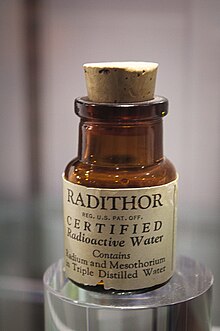
Radium jaw
Radium jaw, or radium necrosis, is a historic occupational disease brought on by the ingestion and subsequent absorption of radium into the bones of radium dial painters. It also affected those consuming radium-laden patent medicines. A patent medicine is an over the counter (non-prescription) medicine or medicinal preparation that is typically protected and advertised by a trademark and trade name and claimed to be effective against some disorders and varying symptoms.
The condition is similar to phossy jaw, an osteoporotic and osteonecrotic illness of matchgirls, brought on by phosphorus ingestion and absorption.
Symptoms
The symptoms are necrosis of the mandible (lower jawbone) and the maxilla (upper jaw), constant bleeding of the gums, and (usually) after some time, severe distortion due to bone tumors and porosity of the lower jaw. Symptoms also include soreness throughout the body, significant decrease in body weight and loss of teeth.
Treatment
Once the symptoms of radium jaw take effect, there is nothing that can be done to reduce the chance of death from radiation poisoning. Radium can cause fatal injuries due to radium and calcium sharing similar chemistry; causing the body to mistake the radioactive metal for calcium and incorporate it into bone tissue. This is significant, because while calcium strengthens bone structures, radium degrades the quality of said bone structure. Alpha particles emitted by the radium leads to bone necrosis and bone cancer.
History
At the start of the 20th century, many believed that radium had beneficial health properties and was often added to consumer products such as toothpaste, hair creams, and even food. Used until the early 1970s, radium was found in some consumer paints, dials on clocks and some industrial applications. Radium was also used in some medical practices during the 20th century.

The disease was determined by pathologist Dr. H.S. Martland in 1924 to be symptomatic of radium paint ingestion, after many female workers from various radium paint companies reported similar dental and mandibular pain. The first written reference to the disease was by a dentist, Dr. Theodor Blum, in 1924, who described an unusual mandibular osteomyelitis in a dial painter, naming it "radium jaw". Symptoms were present in the mouth due to use of the lips and tongue to keep the radium-paint paintbrushes properly shaped. The disease was the main reason for litigation against the United States Radium Corporation by the Radium Girls.
The Radium Girls were female factory workers who contracted radiation poisoning from painting watch dials with self-luminous paint. The incidents occurred at three different factories in United States: one in Orange, New Jersey beginning around 1917; one in Ottawa, Illinois, beginning in the early 1920s; and a third facility in Waterbury, Connecticut, also in the 1920s.
A prominent example of this condition was the death of American golfer and industrialist Eben Byers in 1932, after taking large doses of Radithor, a radioactive patent medicine containing radium, over several years. His illness garnered much publicity, and brought the problem of radioactive quack medicines into the public eye. The Wall Street Journal ran a story (in 1989 or after) titled "The Radium Water Worked Fine until His Jaw Came Off".
Stories such as the Radium Girls and Eben Byers death went public and due to public pressure/outrage, the Food and Drug Administration banned most radiation-based patent medicines in 1932.
See also
- Acute radiation syndrome (not involved in radium jaw)
- Radium Dial Company
- Radium dials
- Phossy jaw
